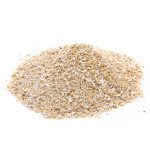 The outside protective shell of any grain.
The outside protective shell of any grain.
The outer coat or layer of a cereal grain.
The outside covering of the wheat seed, removed when making white flour, but an important source of roughage in the diet.
Outer covering of a cereal grain that provides roughage when used as food. Bran is effective in promoting the elimination of solid wastes from the bowel and is recommended by some specialists as an aid to avoid certain diseases (e.g., diverticulosis).
The skin or husk of cereal grains such as wheat, rye, and oats. Bran provides one of the most concentrated sources of dietary fiber. A diet high in bran and other fiber-rich foods helps maintain proper bowel function and prevent intestinal disorders ranging from constipation to irritable bowel syndrome. Additional benefits may include protection against cardiovascular disease, cancer, and diabetes.
The meal derived from the outer covering of a cereal grain. It contains little or no carbohydrate, and is mainly used to provide roughage in the control of bowel function and the prevention of constipation.
The outer covering of cereal grains, such as wheat, oats, and rice, which are rich in hemicellulose. Some of this fiber is insoluble and may be used to add bulk to the diet to help prevent or treat constipation.
Newer medical research has demonstrated that the inclusion of roughage in one’s diet can serve a vital role in the prevention of bowel and colon diseases.
The fibrous outer layer of grains, known as bran, possesses indigestible properties. It serves as a bulk-forming laxative, aiding in the prevention of constipation. By incorporating bran into the diet, individuals can promote regular bowel movements and maintain digestive health.
